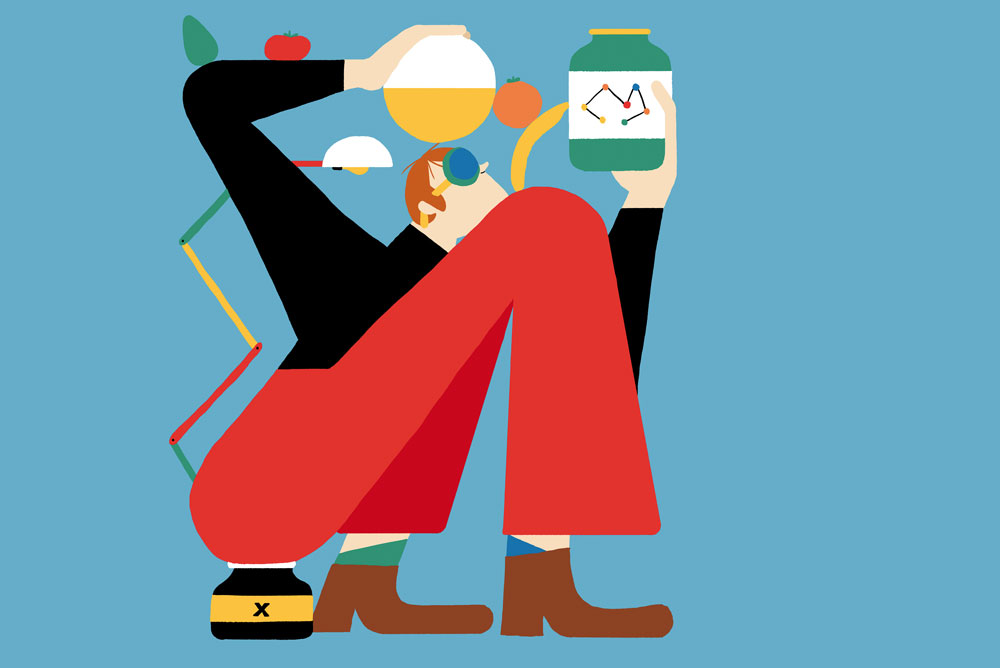How to live to 180: What the actual F is biohacking?

How does this guy do it? Dave Asprey, the world’s most famous ‘biohacker’, is sitting across from me, and he looks healthier and younger – way younger – than the last time I saw him 10 months ago.
He’s more toned, his arms are bigger, the lines on his face are smoother, and hang on, he appears to have youthful dimples in his cheeks. Like a 20-something. Where did the dimples come from? He definitely didn’t have them at the start of the year.
I’ve travelled to Los Angeles to Dave’s 5th annual Bulletproof Biohacking conference. Defined as a ‘systems-thinking approach to our own biology’ or, using the non-geek version, the art of tweaking our diet and lifestyle to improve performance levels and health.
Biohacking is increasingly big business. This gathering sees 2,500 futuristic health-hackers all gathered to try out the latest in everything wellness.
But first, those dimples. How does a man’s face look so different after eight months without surgery? Ordinarily the first thing that would spring to mind is botox. But this is the biohacker with a stated aim of living to the age of 180 and doing it in a healthy way.
First question – how do you look annoyingly younger than last time, while I seem to be ageing not-so-gracefully? ‘My goal is, when I’m 180, to look like I do now,’ Dave says, ‘and that means doing everything possible including stem cell injections.’
NATURAL FACELIFT?
Stem-cell therapy is a process where deposits are taken from somewhere in your body such as the bone marrow or lower back. Growth factors are then separated from these samples, and when you then come back for an injection of stem cells, growth factors and platelets can be injected anywhere in the body.
The potential for this is enormous. Anywhere you’ve ever had chronic pain or have been injured, you can inject stem cells. Or, you can just put them in the face to look more youthful.
Dave has had stem cells inserted not just in his face, but pretty much everywhere in his body. His face, his hair, his blood, and he was the second person in the world to have stem cells injected into his brain. He’s also had them injected into his penis. Which sounds painful.
‘I’m a professional biohacker, I’m willing to try everything,’ he tells me. ‘If you want to be younger, you want to be younger everywhere.’
A few years ago a stem cell treatment would cost $100,000. Now the cost is down to around $5,000, which is all very cool, if you’ve got the cash.
But I know from personal experience that biohacking can be much easier and cheaper than that. What else can he recommend that won’t necessitate a lottery win?
BUDGET BIOHACKS
‘Get off the fried stuff, get off the grains, skip meals if they’re not going to make you feel good, start eating more vegetables, and eat more natural fats such as grass-fed butter,’ he says.
Good Fat vs Bad Fat is a theme at the conference, with 12,000 cups of rich Bulletproof Coffee being drunk (ingredients: coffee, grass fed butter and Brain Octane – a form of coconut oil).
Alongside this celebration of good fats, speakers such as alternative medicine proponent Dr Joseph Mercola warn of the dangers of oils such as canola oil, soya bean oil and vegetable oils on the body. Dave agrees. ‘They’re not proper food,’ he says, ‘though they make good paint.’
Another of his recommendations is a surprise. Dave not-so-surreptitiously sprays something into his mouth twice during the interview. ‘Nicotine,’ he says. ‘It is actually not bad for you; it’s smoking that will kill you.
‘Nicotine is one of the most studied smart drugs and it causes the energy production system in your body to start becoming more productive,’ he says. ‘So quit your smoking and start using another form of nicotine. Don’t fear the nicotine, fear the smoke.’
In fact, many of the recommendations at the conference are the complete opposite of what we are taught about health and this can seem overwhelming…Butter is OK, nicotine’s fine, and so on.
But many other hacks seem to be distinctly old-school. As well as eating plenty of veggies, most of those gathered in LA are big fans of meditation and getting some natural sunlight in the morning.
DAYLIGHT DRUGS
Light is another big theme at the conference. Some speakers talk about how light affects your brain like a drug. Experts and exhibitors alike look at adapting your environment so that the lights around you help you perform at your best, especially if you live somewhere cold, damp and grey, (sound familiar?).
As well as the dearth of natural sunlight in a London winter, some of our offices and devices apparently emit five times more blue light than daylight, which messes up our sleep and circadian rhythms.
There are two solutions, one expensive, one cheap. Dave, obviously, has gone for the expensive one.
‘You could do what I do in the Bulletproof offices – that is control the temperature and colour of the light based on the time of day. Because while you don’t necessarily care what the colour of the light is that you are seeing, your body is looking at the light to figure out what to do and if you give it junk light you won’t get the results you want.’
Installing fancy lights is clearly an expensive hack, so a cheaper one is wearing a pair of ‘blue-blocking’ glasses in the evening or when under artificial light.
This is a favourite look at the conference with delegates wandering around with all kinds of yellow, orange and red glasses on. Some of them look almost cool, in a kind of sub-Bono way. The ones that look like red swimming goggles, though, really shouldn’t be worn in public.
PERSONAL BIOLOGY
One of Dave’s main mantras is that everyone is unique. ‘If I sit down and say this vegetable is good for you, there’s absolutely no evidence of that,’ he says. ‘It may be good for you because it has all these positive effects, but it may be bad for you because it has these negative effects. Your genetic make-up determines whether it’s good for you, and that’s something you have to work out.’
One solution is to cut out certain foods – you could start with nightshade vegetables such as tomatoes and potatoes – and if you suddenly feel younger or more awesome again, then maybe that food isn’t for you.
Another idea could be to use one of the ultra high-tech companies at the conference to analyse your gut for you.
After the interview I slope off to drop $300 on a kit made by a pioneering company called Viome. The founder of Viome is currently mining the moon for minerals with NASA and his kit will, apparently, tell me exactly the foods I should be avoiding via a handy app.
It strikes me as a good way to pay for expensive tests without having an expert to talk me through them afterwards, but I’m keeping an open mind.
One more thing. Does the biohacking world attract obsessive people?
As I walk around the conference wearing my yellow glasses and clutching my newly-purchased stool test, I wonder how normal I am.
Dave has a good take on this: ‘I had spent so many years feeling like crap that you do develop an anxiety around it. But when you start doing the work such as meditation, heart rate variability and eating foods that are biologically compatible with your body, those are the things that allow you to be calm, even if you do have to skip a meal to protect your body.’
FIND YOUR BALANCE:
EASY BIOHACKS YOU CAN DO TODAY
WEAR BLUE-BLOCKING GLASSES
Go geek-chic and block out bright artificial light in the evenings so you can sleep deeper.
READ FOOD LABELS
Don’t eat anything cooked in canola oil, soya bean oil and vegetable oils. Stick to good fats like coconut oil, avocado oil, olive oil and grass-fed butter.
USE VIOME
This futuristic testing kit and app tells you exactly what foods and supplements you should and shouldn’t be consuming.
STEM CELLS
The expensive option. Inject yourself with stem cells and look/feel younger– but be prepared to pay at least £4,000 for the privilege.
SMOKELESS NICOTINE
While nicotine isn’t as bad as you thought, says Dave, smoking most definitely is. Try gums or sprays. Dave claims it helps with coordination, vigilance, memory and reaction speed.













